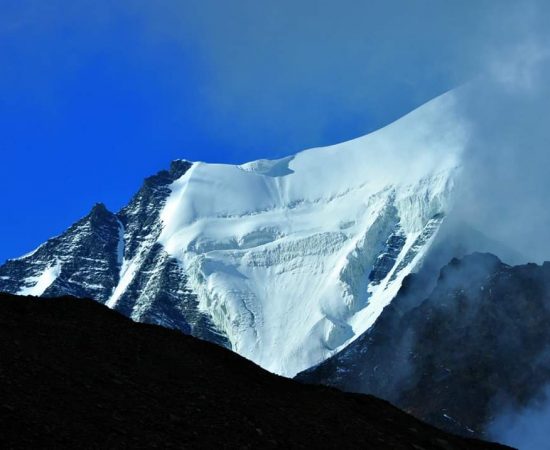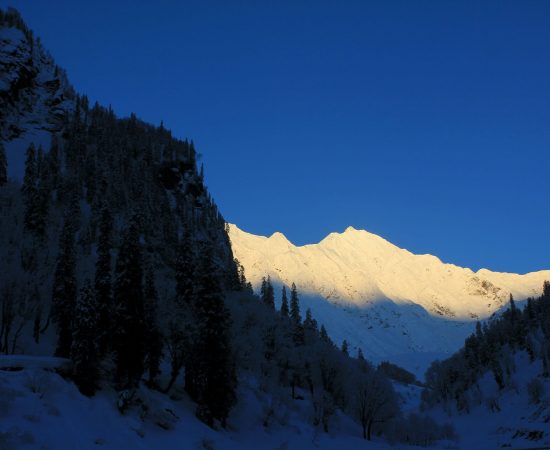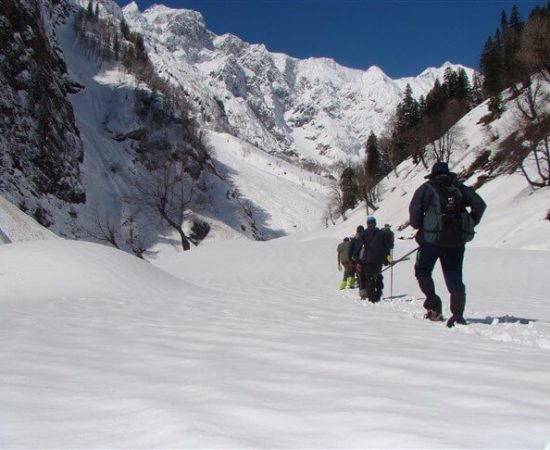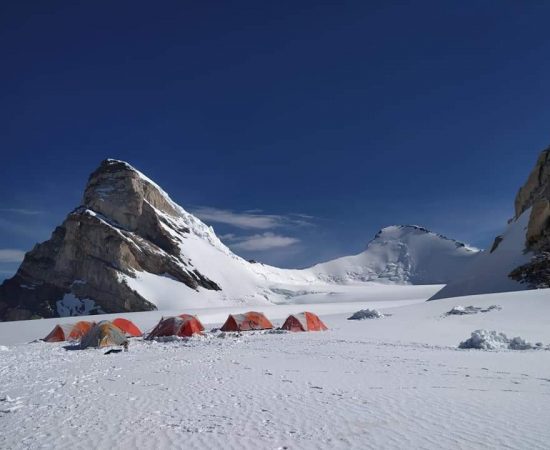Mt. Satopanth Expedition
Uttarkashi, Uttarakhand
Rated 4.9/5.0 on TripAdvisor. 550 Reviews


Key Highlights
- Altitude : 7075 mts
- Time : 26 Days - 25 Nights
- May, June, September, October
- Grade: Difficult
Overview
Mt. Satopanth Expedition
The word Satopanth means "truth path" in Sanskrit. It is in the Garhwal Himalaya area of Uttarakhand that you will find Mount Satopanth. Trekkers hold Mt. Satopanth in high regard because of its combination of a "moderate" technical level and a "complicated" glacier approach. Located in the far-flung Indian Garhwal Himalayan Range, this peak is the second-highest in the Gangotri group. Passionate mountaineers who want to go from walking to climbing peaks and experiencing the high alpine environment at 7,000m will find this to be a persuasive strategy. Incredibly stunning and isolated areas with sweeping vistas of the Bhagirathi mountains and Gangotri Glacier may be reached by winding routes that skirt the cliff faces. The first part of the trail is a flexible glacier ascent, followed by steep snow slopes and the last push to the peak. High altitude (slightly over 7,000 m) has a role, as does the location's isolation and the risk of drastic weather shifts. If you're new to technical climbing, Mt. Satopanth is a great place to get some practise with crampons, fixed ropes, and jumars. The beauty of this journey lies in the sights of Thalay Sagar, Shivling, and the scary granite pillars of Bhagirathi III. Along the way, you'll be treated to sights that will bring back fond memories years from now. While relaxing in Vasuki Tal's welcoming embrace, the journey to the next Base Camp will be tough, instilling you with renewed vigour. We'll be stopping at a few different camps on the way to base camp at an elevation of around 5,000 metres before we finally reach the summit. In addition, three further camps will be established before the summit is attempted. The trail becomes difficult beyond the starting point, with obstacles including ice gullies, glaciers, and steep slopes of anguish. Summit attempts will be made in the wee hours, with careful navigation of ice slopes, in order to reach the peak, take in its pristine splendour, and then descend carefully to the lower camps. It is common practise to conduct the excursion between July and September, when the weather is mild and may be used to one's advantage. When we return home after more than three weeks of climbing in isolation, we will have unforgettable experiences to share with our friends and family.
Cost Per Person
Key Highlights
- Altitude : 7075 mts
- Time : 26 Days - 25 Nights
- May, June, September, October
- Grade: Difficult
Complete
Itinerary of Expedition
You have arrived in Delhi, India's federal capital. When you arrive at Delhi International Airport, a representative of ours will be there to meet you and help you with any necessary arrangements before taking you to the hotel you've reserved for the night.
Have breakfast at the hotel before heading to the Indian Mountaineering Foundation (I.M.F) for a briefing and to take care of any necessary paperwork. Travel to Rishikesh in the afternoon and settle into your accommodation there. Get cleaned up, have a good meal, and chill out for the night.
On the third day of the journey, you will leave Rishikesh and travel almost 175 kilometres to Uttarkashi. Crossing Mussoorie and taking the picturesque route with views of the great Himalayan Peaks. After reaching Uttarkashi, we will set you up at a lodging. Evening time is for leisure to enjoy the township in between the tall mountains. You can even take out time to engage in watersports.
After a hearty meal, you should be ready to finish out the expedition's paperwork. For the required paperwork, you'll have to pay a visit to the Forest Department, the Nehru Institute of Mountaineering, and the Superintendent of Police. The next stop is Gangotri, which is just 100 kilometres from Uttarkashi. One of the finest hotels in Gangotri will be reserved for you for supper and the night.
Beginning today, you'll begin your walk by ascending the hills to Bhojbasa, located 3,780 metres above sea level. You'll go a total of 14 kilometres over the course of about 6 hours on this hike depending on your speed. You'll be able to take in breathtaking vistas of the surrounding snow-capped mountains and other breathtaking Himalayan scenery all along the path you have just trekked. After reaching Bhojbasa, establish our campsite.
Our journey today takes us on a pleasant ascent to Gaumukh, often known as "The source of River Ganges," where we will be rewarded with stunning panoramas of both Mt. Shivling (6543 m) and Mt. Bhagirathi (6856). To continue, go slightly upwards in the direction of Nandanvan. Cut past the glacial moraine on the Gangotri glacier and you'll come to the expansive alpine meadow of Nandan Van, which sits at the confluence of the Chatrungi and Gangotri glaciers at the foot of Baghirathi I (6856 m), Baghirathi II (6512 m), and Baghirathi III (6603 m) (6454 Mts.). You can see the peaks of Kedar Dome (6831 m), Karcha Kund (6617 m), Kedarnath (6940 m), and Meru (6672 m) over the Gangotri Glacier. Tent Camping in Nandanvan for the Night. Meals: Three meals a day
After a hearty breakfast, we'll set out on a 10-kilometer (4- to 5-hour) hike to Vasuki Tal, at 4,500 metres, the location of Mount Satopanth's base camp and our home for the next two weeks. As soon as you get there, establish a camp to spend the night in.
You may unwind in peace and quiet throughout the day without worrying about a timetable. Today, you will do nothing but sleep or go out into the surrounding region of the base camp. There are also breathtaking panoramas of the snow-capped mountains and the natural splendour of the region. The climbers will spend the night in tents.
In order to reach the Chaturanga Glacier, which lies to the right of Vasuki Parbat, you will have to traverse a small ridge on the ninth day of the Satopanth trip. Enjoy breathtaking views of Satopanth Peak from the ridge's edge. As time passes, you should begin your descent toward the Sundar glacier and the advanced base camp.
Acclimatization is all that will be left to you each day, since there is no set routine. However, it is possible that you may ascend a short hiking track in the afternoon. Get to the campsite early enough to enjoy supper and a good night's sleep under the stars.
Have a hearty breakfast to kick off this glorious day before beginning the first tough ascent of the trek. We will be needing to fix rope in order to make the climb from ABC to Camp 1, so, our team’s lead climbers will be going ahead to open the route while we follow. Fixing ropes and opening the route is going to make the next day’s trip easier. Retrace yourself back to ABC where you will be spending the night.
Today is the first day of your formal technical climbing training. You'll be navigating a rock band and an ice gully after a little stroll on the glacier. Base Camp 1 is located at an altitude of over 5800 metres above sea level, and may be reached after a short walk over a few moderate humps.
You should have breakfast first thing in the morning before getting ready to hike to a particular elevation and then returning to campground 1 for supper and nighttime.
Today is a day of relaxation and for the journey to Camp 2.
We will make our move from Camp 1 to Camp 2 today. After reaching Camp 2 we will properly set up our campsite and occupy it.
There is a shorter, steeper route to the lesser-known 'knife ridge,' so be prepared. You should participate in a rope-fixing exercise as preparation for your climb to the summit camp. After the crossing ,it will bring you to the mountain's steep, ice face, from where you may see the surrounding mountains. Set your camp on the ridge just above the hanging glacier. Prepare yourself in this strategic spot to make the climb to the summit.
It is planned that you will make an attempt on the peak in the morning, and then retreat to camp 2 in the late afternoon for the night's stay and delicious meal.
Keep two days of supplies at the peak in case of inclement weather.
The trek back to base camp from Camp 2 will take almost two full days. In order to maintain your energy for the duration of this descending exercise, make use of the meals provided at the camps and tents.
Prepare a hearty breakfast and relax with a refreshing morning after a good night's sleep. Now is the time to get your stuff together and start making the journey to Bhojbasa. Make camp when you get to your day's destination.
After breakfast, you should begin the descent to Gangotri from Bhojbasa. The trip to Uttarkashi will begin after you reach Gangotri. To spend the night, please check in to the resort or hotel.
If you want to visit Rishikesh, India's yoga capital, you should get in the car and go right after breakfast. After completing the necessary procedures, check into your hotel room. After seeing the Ganga Arti at Ram Jhula, you may retire for the night.
Eat breakfast and hit the road; upon arriving in Delhi, settle into your hotel for the night for a restful supper and evening.
After breakfast, you should go over to the International Monetary Fund for a briefing. You may do anything you choose with the remainder of the day. Follow the check-out procedures so that you may get on your aircraft and return home.
Enquiry For Group Bookings
Guidelines
➽ Preparation for Expedition
As you know every mountainous excursion demands a precise planning, a planning with adequate pliability of observing and tackling situations, held all as by overcoming mind body and soul throughout the incredible Himalayan journey.
So here are some aspects regarding Mt. Satopanth Expedition preparation:
⦿ Physically – A trek demands physical endurance, to prepare for each trek you should work out a month before joining a program. Build up the adequate strength in your legs by running and exercising every day to boost up your endurance. Stop smoking and boost your lungs doing breathing exercises at routine basis two times a day, which will help acclimatize the conditions while being resilient on the trek. Take active part in outdoor games, Yoga and any other cardiac exercises.
⦿ Mentally – Mental preparation is key, equally as important as physical training requisite for a trek. Before joining any trek take pleasure in your daily routines, eat well, take rest properly and relax. Do not stress your mind by unnecessary predictions about the trek. Be with your best friends to get motivated and relax your mind. Because pre trek assumptions are not worthy because once you join the trek and meet with rest of the pack will bring encouragement and excitement. The mental preparedness will build through the entire trek conditions. And the physical drawbacks will affect the mind. So pay close attention to various parts of the body and consciously let them loosen up as you trek. When you trek try to relax your body, especially your hips. If you’re on a winding downhill trail or on a panicking slant, think of each step as part of a simple dance and enjoy the natural rhythms that the terrain and your body can find together cautiously. Experiment with different ways of walking as a way of finding enjoyment beyond the goal of reaching a destination. The main key to stay mentally fit is to enjoy the route and not to pressurize the mind.
Guidelines
➽ Things to Carry
- Good Trekking Boots: You need sturdy trekking boots with supportive high ankles. Don't bring your running shoes. U can carry extra floaters/flip flops also.
- Wear warm clothing, such three-layer coats, fleece upper, hollow fill or down-filled jackets. Carry full-sleeved T-shirt. Carry cotton hiking trek pants and warm pant for your lower body. Never bring shorts or jeans on a hike.
- Take top and bottom thermals with you.
- Quick dry towel with light weight and Personal toiletries. Suns cream lotion, sanitizer, tooth brush ad toothpaste, lip balm and antibacterial powder.
- Socks: Bring two pairs of regular socks and two pair of wool socks for wearing at night.
- A head torch is required.
- Sunglasses/ Goggle: UV-protected sunglasses are necessary to protect against sunlight and Snow Mountain.
- There should also be a woolen cap / balaclava, cap, neck gaiter cum face mask and warm fleece and waterproof summit gloves since it will be chilly. Keep waterproof gloves on hand since they become wet in the snow.
- Everyone taking part in the activity should have their own lunchbox, spoon, mug and water bottle/ hydration pack of 2 ltr.
- Raincoats/ponchos: Since snowfall and rain are frequent at high elevations, it is important to have one on hand so as to avoid getting wet.
- Trekking bag of 75 ltr with rain cover.
- Walking stick.
- Personal first aid box. Emergency ration, energy bars, dry fruit, electoral/Ors
- Personal technical gears list of mountaineering (on rent basis available)
- Climbing boot, Crampon, Sleeping bag (optional), Ice axe, seat harness, Rope and tape sling, helmet, Summit gloves, Gaiters, Carabineers 2 no (screw), figure of eight/descendor, Zumar (Ascendor),
- Required Documents:
a) Registration Form
b) Medical Certificate (signed by a licensed MBBS physician)
c) NOC form (completed by the trekker)
d) 2 passport-size photos
e) ID Proof photo (not PAN)
f) Basic Mountaineering Course certificate.
g) Insurance upto 5 lac..
➽ Trip Cost Includes
- Mountaineering (Instructor/guide) services provided by a highly trained, professional, and qualified Himalayan Adventure Trips staff.
- Certified local guide with extensive familiarity of the area.
- Climbing provides only vegetarian food (breakfast, lunch, and dinner).
- Staff include chefs, cooks, and helpers.
- High Altitude Force, Low Altitude Force, Porters, Mules for Common Equipment (Rations, Tents, Utensils, Central Climbing Equipment, etc.)
- Tents (to be shared), sleeping bags, air mattresses, and air pads are included. Inner
- We offer twin-share accommodations in dome, alpine, and high-altitude tents on all of our treks and expeditions. All necessary camping equipment, including air mattresses, a shelter for cooking and eating, a table and chairs, a stool, and more, would be supplied.
- Someone who can carry heavy items, set up high camps, repair ropes, etc. at high altitudes.
- Assistance from Guide All the Way to the Top
- High-altitude butane gas cooker
- The only meal offered at the hotel will be breakfast. All meals while on the walk will be supplied for you. Indian, Chinese, and Continental cuisines, all freshly cooked, will be on the menu.
- Tin-packaged food is what we'll eat at high altitude.
- A standard first aid kit with oxygen masks for the patient.
- Camping fees, wildlife fees, and forest permits.
- Taxes imposed by the state.
➽ Trip cost Excludes
- Climbers may hire individual porters to carry their gear.
- Airport transportation costs
- Expenses for carrying still/video cameras etc.
- Irregular/Personal costs, such as laundry, phone calls, and gratuities.
- Climbing equipment such as ropes, pitons, snow bars, crabs, etc.
- Your own personal mountaineering equipment and clothes, as well as any specialised foods you may need
- Inner Line Permit.
- Health coverage or the price of a rescue mission
- Expenditures of a more personal character (such as booze, soda, bottled water, mineral water, canned or bottled drinks, candy, canned or packaged dried fruits, etc.)
- Provisions/food to or from the starting point of the trek.
- Any expenses that are incurred as a result of natural disasters, human error, or other unforeseeable occurrences.
- Protect your trip with a travel insurance policy.
- Authorization, licensing, and enlistment with the IMF.
- Payment for Liaison Officer (included for foreign expedition only)
- GST of 5%.
Guidelines
➽ Special Casual Leaves
Government employee can avail the benefit of special casual leave when u join us for a trekking expedition. As per the rule of the pay commission, special casual leave can be availed for up to 30 days in a calendar years for trekking and mountaineering expeditions through a register organization. Himalayan adventure trips are a register adventure tour operator register with Indian mountaineering foundation and Himachal Pradesh tourism. Candidates have to apply for leave at least 30 days before the trek/expedition start.
Testimonials
➽ Provided By The Customers
Everything about our visit to Prashar lake was better than we could have imagined. From our initial contact with Himalayan Adventure Trips, we felt their genuine interest in learning about our group's goals and expectations, and our travels with them reinforced at every turn that they not only understood our requirements but also have the acute skill and expertise to achieve them. Having already had such a wonderful experience with this firm, I will be promoting a trek to Prashar lake to all my friends who share my passion for hiking and will specifically recommend that they work with this outfit. Absolutely fantastic; I have nothing but praise for it.
How useful was this post?
Click on a star to rate it!
Average rating 0 / 5. Vote count: 0
No votes so far! Be the first to rate this post.






